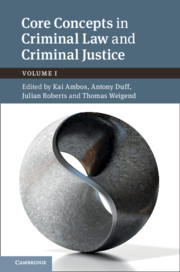Book contents
- Core Concepts in Criminal Law and Criminal Justice
- Core Concepts in Criminal Law and Criminal Justice
- Copyright page
- Contents
- Preface
- Abbreviations
- Contributors
- Part I Introduction
- Part II Criminal Law
- Part III Criminal Justice and Procedure
- 7 Proportionality of Punishment in Common Law Jurisdictions and in Germany
- 8 Criminal History Enhancements at Sentencing
- 9 Due Process
- 10 The Role of the Prosecutor
- 11 Negotiated Case Dispositions in Germany, England and the United States
- 12 Exclusion or Non-Use of Illegally Gathered Evidence in the Criminal Process: Focus on Common Law and German Approaches
- Index
- References
8 - Criminal History Enhancements at Sentencing
from Part III - Criminal Justice and Procedure
Published online by Cambridge University Press: 19 December 2019
- Core Concepts in Criminal Law and Criminal Justice
- Core Concepts in Criminal Law and Criminal Justice
- Copyright page
- Contents
- Preface
- Abbreviations
- Contributors
- Part I Introduction
- Part II Criminal Law
- Part III Criminal Justice and Procedure
- 7 Proportionality of Punishment in Common Law Jurisdictions and in Germany
- 8 Criminal History Enhancements at Sentencing
- 9 Due Process
- 10 The Role of the Prosecutor
- 11 Negotiated Case Dispositions in Germany, England and the United States
- 12 Exclusion or Non-Use of Illegally Gathered Evidence in the Criminal Process: Focus on Common Law and German Approaches
- Index
- References
Summary
A defendant’s prior crimes affect decision-making throughout the criminal process, from decisions taken by the police, prosecutors and investigating magistrates (bail), through to prison and parole authorities considering whether to release prisoners. It is at sentencing however, that criminal history has the greatest impact on decisions and the lives of defendants. Of all the aggravating factors, a criminal record is the most commonly invoked, the most powerful and also the most controversial. In general, people with prior convictions are treated more harshly in all criminal justice systems, civil and common law. This near-universal sentencing policy is variously described as a Recidivist Sentencing Premium, a Prior Record Enhancement, or Criminal History Enhancement; the German term is Strafschärfung für Rückfalltäter or, briefer, Rückfallschärfung. The penologist Nigel Walker referred to prior convictions as ‘the most obvious example of aggravation’ and Hessick and Hessick described the recidivist sentencing premium as ‘one punishment issue on which everyone seems to agree’. In this chapter, we argue that it is neither as obvious nor as consensual as these quotes suggest. Other authors seem closer to the truth when they describe ‘the controversial question of sentencing repeat offenders’.
- Type
- Chapter
- Information
- Core Concepts in Criminal Law and Criminal Justice , pp. 261 - 303Publisher: Cambridge University PressPrint publication year: 2020



